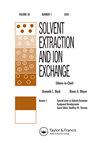二乙醇酰胺萃取剂与f元素结构性能关系研究进展
IF 2.1
4区 化学
Q3 CHEMISTRY, MULTIDISCIPLINARY
引用次数: 2
摘要
摘要二甘醇酰胺(DGAs)属于CHON型化合物,可与金属离子形成三齿配合物。基于DGA的萃取剂由于其对三价锕系元素和镧系元素异常高的亲和力而成为锕系化合物分配中备受关注的主题。由于DGA的分离性能与其分子结构密切相关,已经提出了许多结构修饰方案,例如将不同的烷基取代基连接到酰胺N原子上或将多个DGA臂锚定在支架上。本文综述了描述这种改性对DGA结构和性能影响的文献报道。通过比较不同结构DGA萃取剂的萃取和分离性能,讨论了DGA的结构与性能之间的关系。这些工作应有助于更全面、准确和深入地了解待开发DGA的结构和性能之间的关系。这也应该有利于更多新型DGA萃取剂的结构设计。本文章由计算机程序翻译,如有差异,请以英文原文为准。
Recent Progress on the Structure-Performance Relationship between Diglycolamide Extractants and f-Elements
ABSTRACT Diglycolamides (DGAs) belong to the class of “CHON” type compounds and can form tridentate complexes with metal ions. DGA-based extractants are a subject of great interest in actinide partitioning due to their exceptionally high affinity for trivalent actinides and lanthanides. Since the separation performance of DGAs are closely related to their molecular structures, many structure-modification schemes have been proposed such as the attachment of different alkyl substituents to an amidic N atom or anchoring multiple DGA arms onto a scaffold. In this paper, literature reports that describe the effects of such modifications on the structure and performance of DGAs are summarized. By comparing the extraction and separation properties of DGA extractants with different structures, the relationship between the structure and properties of DGAs is discussed. Such work should be helpful for gaining a more comprehensive, accurate and in-depth understanding of the relationship between structure and property of DGAs to be developed. It should also be beneficial for the structural design of more new DGA extractants.
求助全文
通过发布文献求助,成功后即可免费获取论文全文。
去求助
来源期刊
CiteScore
4.40
自引率
5.00%
发文量
15
审稿时长
8.4 months
期刊介绍:
Solvent Extraction and Ion Exchange is an international journal that publishes original research papers, reviews, and notes that address all aspects of solvent extraction, ion exchange, and closely related methods involving, for example, liquid membranes, extraction chromatography, supercritical fluids, ionic liquids, microfluidics, and adsorption. We welcome submissions that look at: The underlying principles in solvent extraction and ion exchange; Solvent extraction and ion exchange process development; New materials or reagents, their syntheses and properties; Computational methods of molecular design and simulation; Advances in equipment, fluid dynamics, and engineering; Interfacial phenomena, kinetics, and coalescence; Spectroscopic and diffraction analysis of structure and dynamics; Host-guest chemistry, ion receptors, and molecular recognition.

 求助内容:
求助内容: 应助结果提醒方式:
应助结果提醒方式:


